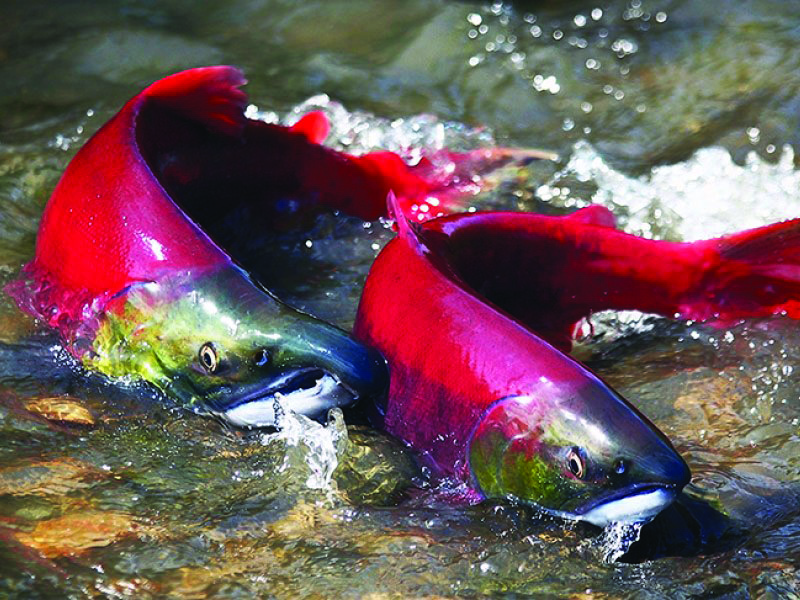Lower Snake River dams: To breach or not to breach?
The lower Snake River dams need to be breached to ensure the survival of Idaho’s wild salmon.
As fifth-graders in the Lewiston School District, many students took part in raising steelhead in our science curriculum. Every day the lunch line would wrap around the 55-gal. tank where the steelhead roe lay. Little did those students know that salmon and steelhead had been listed as endangered species for more than 20 years.
On June 9, Washington State’s Sen. Murry and Gov. Inslee released a draft report detailing the issues of salmon extinction concerning the four Lower Snake River dams. In summary, the report revealed that the energy from the dams is fully replaceable and breaching is a needed measure to fully recover salmon populations. Now, all that is left is the question of breaching. Breaching the four Lower Snake River dams is a necessary measure to ensure tribal justice, keep the Pacific Northwest ecosystem happy and secure salmon as a species for future Idahoans.
The Lower Snake River dams were built between 1957 and 1975. Salmon runs in the Columbia and Snake rivers have declined over 90% in the last 100 years, as reported by the Washington Department of Fish and Wildlife, as well as the Oregon Department of Fish and Game. Salmon are magnificent creatures that happen to live in our backyard as residents of Lewiston.
Salmon are born as freshwater species. They then begin the first portion of their migratory cycle, seaward migration. Once in the ocean, their gills and kidneys adapt to the saltwater environment. Depending on the species of salmon, they may spend 18 months to eight years in the ocean before converting back to freshwater and swimming back upstream, where they will spawn, die and deliver nutrients back to the environment around them through their decomposing bodies. Dams impact salmon in many ways, from rising water temperature to changing river flow patterns and permanently blocked fish passage. All of this contributes to fewer and fewer salmon making it to the ocean and back. Their complete 900-mile trip is one of the most extraordinary migratory patterns on planet Earth.
Many Native groups of the Pacific Northwest describe themselves as Salmon People. For generations, salmon have been seen as a gift from the Creator, sacrificing themselves in many ways to help and guide many tribes of the area. Salmon are a part of a spiritual and cultural identity for many indigenous groups, and they are honored in various special ceremonies. In return, at the front face of salmon recovery have been native people stressing the deep relationships found within their love for salmon. Ensuring the survival of this sacred animal is a needed part of tribal justice for the Columbia Plateau Tribes and more.
Activism surrounding this issue has been nothing short of noteworthy, specifically from younger generations of Idahoans and Pacific Northwest residents. “Clean energy at the cost of a keystone species isn’t clean energy at all,” said Maanit Goel, 16, of Sammamish, Washington, in an interview outside of The Bengal’s Purr. “Salmon survival must be non-negotiable, especially when we have the resources to accommodate it alongside clean energy.”
In Boise, Lizzy Duke-Moe, 19, also spoke out about the issue.
“As an Idahoan who enjoys the wilderness, I was devastated to learn that in the past 100 years, 40% of salmon grounds in Idaho have been damned to extinction,” Duke-Moe shared. “My fellow youth and I are chasing a future where salmon return to alpine lakes and saturate the soil, people and water around them with nutrients. We will not stop until then.”
Another teen, Henry Roller, 19, said, “I care about restoring the Snake River because the critically endangered southern resident orcas are starving to death.” He added that they rely on the salmon of the Columbia and Snake rivers for over half of their diet, and now there are only 75 whales left.
It’s necessary to listen to biologists and remove these dams. This will ensure that salmon are still here 10, 20, 50 years down the line for future generations to enjoy, study and fish.
Salmon are keystone species to the Pacific Northwest that complete one of the world’s greatest migrations right in our backyard. There are currently 14 species of salmon listed under the Endangered Species Act. Breaching the dams is necessary for tribal justice, keeping the ecosystem happy, and secure salmon as a future species. As drastic as the breaching of a dam may seem, it will never compete with the loss of life and culture that are parallel to salmon extinction.






